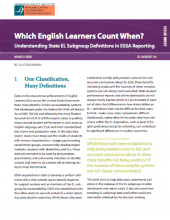Which English Learners Count When? Understanding State EL Subgroup Definitions in ESSA Reporting
Data about English Learner (EL) students in the United States are more plentiful than ever. Under the federal Every Student Succeeds Act of 2015 (ESSA), states must report a wide range of information about their students’ English language arts and math standardized test scores, graduation rates, and more. They must also break these data down to show how students with certain characteristics—subgroups including racial/ethnic groups, students with disabilities, and ELs—are doing.
This wealth of data is meant to help policymakers, practitioners, and community members identify schools that need to do a better job of helping ELs learn. But for this to be possible, it must be clear who states are including in the EL subgroup—something that varies across types of data and that is not always clearly marked on state student performance reports or online dashboards.
This brief aims to help data users understand how the composition of the EL subgroup varies, and why understanding these technical differences matters when making decisions about how ELs and schools are faring. It also discusses how breaking data out further for certain groups of ELs such as newcomers, students with interrupted formal education, and long-term ELs could benefit decision-making.
Sugarman, J. (2020, March). Which English learners count when? Understanding state EL subgroup definitions in ESSA reporting. Migration Policy Institute: https://www.migrationpolicy.org/research/state-english-learner-subgroup-definitions-essa

